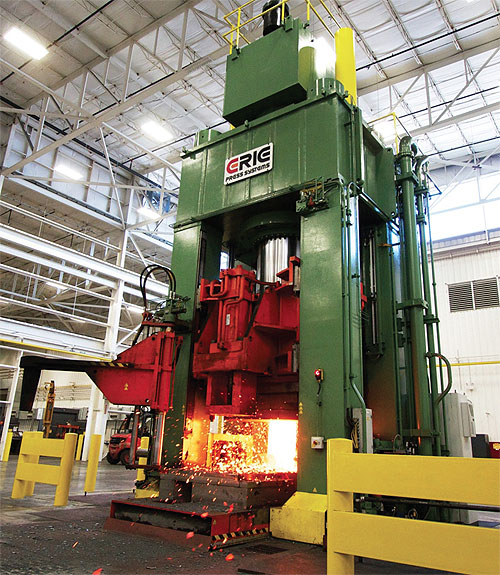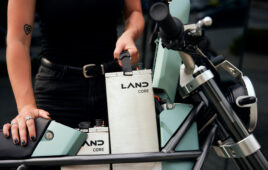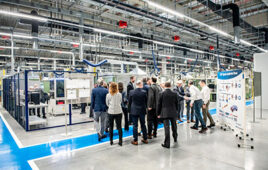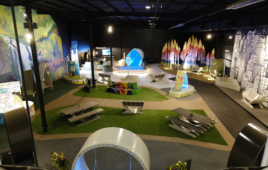By Paul J. Heney, Editorial Director
Erie Press started small in the forging business, producing cast-iron skillets and pans using a die hammer. Eventually, Erie Press decided to focus on the manufacture of these giant hammers. After World War II, demand for forging hammers fell. To survive, the industry needed to adapt—this came in the form of the hydraulic press. Powered by hydraulic motors, these forging machines produce considerably more force than their predecessors. When they were eventually automated using computer systems, hydraulic presses became even faster, stronger and more precise.

Bringing a ton of pressure to bear on hot metal creates tremendous noise, heat and other potential safety hazards for workers. For their owners, the machines’ powerful pressure comes with high energy costs and a lot of wear and tear on expensive components, such as the hydraulic pumps.
McInnes Rolled Rings brought these concerns to Erie Press when McInnes decided to invest in a new forging machine: A 3500-ton ring preforming press. McInnes manufactures seamless rolled rings ranging from 4 to 144 in. in diameter, using carbon, alloy and stainless steel. The company wanted its new, three-story hydraulic press to consume less energy than its predecessors. In common presses, the hydraulic motors run whenever the machine is on, even if the press is not being used—wasting energy and increasing wear and tear on a machine that costs between $10 million and $20 million upfront.
Drives are typically used in other types of machines to cut the power from the motor when it is not needed. But machines the size of the presses that Erie Press creates, many weighing more than 3000 tons, have long been considered too large to effectively install drives.
Without drives, conventional press operators are forced to turn the motor off between presses to limit energy use. While intuitively sensible, starting from “off” each time the massive hammer presses metal consumes an immense amount of energy.
“Think of it like a car. Slamming your foot on the gas, going from zero to 60 as fast as possible, requires a lot of fuel—much more than starting at 5 mph and gradually speeding up to 60,” said Bill Goodwin, sales manager for Erie Press. “Hard stops and starts are also hard on the hydraulics, leading to more maintenance and potential breakdowns. Ultimately, this sudden burst of activity can shorten the life of the machine.”
A broken machine is an unsafe machine, especially when its function is to apply one ton’s worth of pressure to manipulate hot metal. This safety risk, coupled with maintenance issues and, most importantly, high energy costs caused Erie Press to seek a new solution for McInnes’ press with Rockwell Automation.
For the first time, Erie Press designed a drive into one of its presses—an Allen-Bradley PowerFlex 755 variable frequency drive (VFD) with a power range that extends up to 2400 hp. The VFD controls the frequency of electrical power supplied to the motor, distributing the right amount of power when the motor is in use and allowing it to idle between pressings.
Because of this, simpler and more cost-effective, fixed-volume pumps were installed. Unlike the variable pumps Erie Press had been using, fixed pumps only allow a certain amount of oil to cycle through the pump.
“Because of the drive’s ability to manipulate the speed of the motor, these pumps are always in the sweet spot,” Goodwin said. “They never apply too much pressure or too little—it’s always just right.”
Due to their size and power, these presses depend upon a variety of safety devices, from light curtains to emergency-stop circuits that are tightly coupled to the press’s operation, to keep employees out of harm’s way.
In the past, Erie Press would employ multiple safety relays and input/output (I/O) channels to communicate the machine’s status with the process controller. A GuardLogix controller helps simplify this process by linking the safety circuit directly to the machine control process. This allows the I/O module to be placed near the safety devices, reducing excessive wiring, and improving system debugging and commissioning times.
To further ease the operating, monitoring and maintaining of the McInnes machine, Erie Press installed a FactoryTalk View SE software running on a PanelView Plus 6 15-in. touchscreen. The HMI provides users with a “window” into the press through extensive on-screen diagnostics, “red/green” indicators that show press startup progress, and error messaging and logging.
Electrical and hydraulic schematics, as well as operator and maintenance manuals, are readily accessible on-screen in PDF form, so operators can troubleshoot critical components without leaving the machine, allowing for faster commissioning.
A virtual private network (VPN) connection point is installed in the control enclosure of each machine. This point links to authorized computers across the world, enabling customers to monitor their machine without being in the factory. This also allows customers to remotely share their machine interfaces with Erie Press personnel, who can assist them with their maintenance challenges.
The new machines use 30% less energy than conventional presses. The PowerFlex 755 drive also eliminated the need for variable volume pumps, allowing Erie Press to choose fixed-volume pumps, which are 35-40% cheaper. Considering that this particular press used eight such pumps, the savings was significant.
In addition, the drives allow hydraulic pumps to run at a speed below 1800 rpm. This not only saves energy, but reduces pump noise and heat, lessening the need for sound protection and cooling inside the plant. Since hydraulic pump life is based on pump rotation, reducing the speed of the pumps increases their life by reducing wear and tear.
“The drive, controller and other components from Rockwell Automation were critical in meeting the needs of our customer,” Goodwin said. “Equally important was the collaboration we received from the people at Rockwell Automation. They did for us what we try to do for our customers—develop a unique solution by innovating together.”
Rockwell Automation
www.rockwellautomation.com
Filed Under: Green engineering • renewable energy • sustainability





Tell Us What You Think!